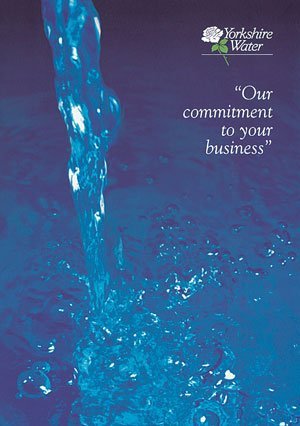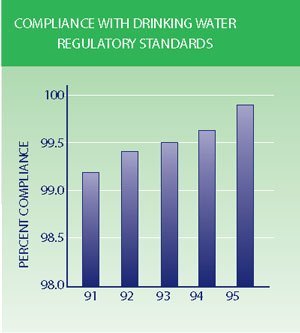
We all have different needs. If you were asked what they were you might talk about the need to buy a motorbike, to have enough money to go out on Friday night or to buy some new clothes. Water affects all of our lives in many different ways but it is probably something which is not instantly associated with your needs because it is taken for granted. Think how many times a day you use a tap, not just for washing your hands but also for making a cup of tea or coffee, for cooking, washing clothes, cleaning, running heating systems, washing-up and, of course, for flushing the toilet. Imagine what it would be like if water was not readily available. Perhaps the best way is to think of a seed and the ingredient necessary for it to germinate and grow – water. Like that seed we depend upon water but not only in its capacity as a necessity to support our existence but also for developing our standard of living. For example, in a modern home water must come into the house. We may have access to it both upstairs and downstairs. Water may be used in the heating system, the shower in the bathroom and for the washing machine. The demand for water has risen steadily over the last ten years, with the greater use of domestic appliances such as dishwashers and the installation of garden watering systems all adding to this demand.
We must not forget that water is not just for our everyday needs in domestic consumption. Industry needs water, sometimes in very large quantities. Many of these industries may supply us with products; consumables such as food, manufactured durables such as television sets and not forgetting energy produced from water to power electrical products in our homes. Service industries also need to use water in the workplace, though perhaps not in such large quantities.
So, what does all this add up to? Water is a very important product for us all. Within the home it helps us to maintain and develop our very standard of living. If a direct comparison is made with a household of 100 years ago and a modern household, one of the first things we would notice is how differently we use water today. It is not just the way water is used which represents the change in our needs. Modern customer expectations require high standards of performance for any product they buy and from any service they receive. By providing a vital service for industries, water helps to create the products and services required for our everyday needs whilst at the same time helping these organisations to develop, expand and grow, provide jobs, create wealth and provide us with a living environment in which we live more comfortably than in the past and in which there is greater choice of goods to buy and activities to enjoy.
Changing customer expectations

1st September 1989 was a critical date for the water industry in England and Wales. It was the date which signalled the reorganisation of the water industry through the process of privatisation. Yorkshire Water Plc became one of the ten Water Service Companies (WSCs) in the UK formed by the Water Act of 1989. Its core responsibility was to provide water supply and sewerage services to an area of over 13,000 sq km in Yorkshire. This meant providing drinking water to over 4.5 million people and treating effluent from people and industry to an equivalent of 7.5 million people.
Though privatisation on the one hand represented the end of public sector constraints, on the other it meant having to use these new found freedoms responsibly. There were many concerns that prices would go up, standards of service would go down, that customers would be neglected and that the environment might be damaged. Many of these concerns were unjustified. For Yorkshire Water it meant no more battles with Whitehall, the freedom to manage, being able to plan ahead and to borrow from the most effective source. But, whereas in the past water authorities had the role of gamekeeper and poacher, in the private sector Yorkshire Water and the other Water Service Companies became amongst the most regulated companies in the world.
Whilst drinking water standards and the actions of Yorkshire Water are monitored by domestically based organisations such as the Environment Agency, the Office of Water Services, the Drinking Water Inspectorate and the Office of Fair Trading as well as other consumer legislation, the European Union Directive on the Quality of Water for Human Consumption sets stringent minimum standards for over 50 different substances and has been incorporated by the UK Government into the Water Supply (Water Quality) Regulations. OFWAT is the regulatory body, independent of the water industry, which protects the interests of customers by ensuring they are provided with water and sewerage services which meet statutory standards and are within the price limits set (i.e. that customers get a good service at a fair price).
At the same time, customer perceptions have changed. In the consumer-orientated society in which we live, customers demand exceptionally high standards from service providers. Changes such as exposure to different cultures and lifestyles, increasing consumer choice, better mobility and education standards have resulted in far more demanding and sophisticated customers. In fact, customers want Yorkshire Water to be honest and open and they also want high quality services representing good value for money. For Yorkshire Water, the move towards consumerism is not just about meeting consumer needs with high service standards for its products, but also about how it deals with customers to provide superior customer care.
A commitment to water quality standards
A standard is a fixed basis against which something can be measured. For example, if more people pass a business studies exam from one year to another and other things are equal, we could say that standards have improved. If fewer pass, then they will have fallen. This is particularly important for a business because standards:
- help to identify and deal with problems;
- provide a measure against which the performance of the company can be evaluated;
- assist with the forward planning of the business;
- provide better standards of efficiency and service for customers.
Water for Yorkshire Water customers comes from a variety of sources; about one half from moorland reservoirs, one quarter from rivers and one quarter from boreholes. A small amount is obtained from springs. Yorkshire Water provides reports on the quality of water for every area of supply. The reports give information on the type of water supplied and the results of tests on samples taken throughout the year from where treated water is stored and from customers’ taps and these are then compared with UK drinking water standards.
Quality standards

Drinking water quality is constantly tested for a very good reason, that of safety. Drinking water must be safe to drink. During a normal year, more than 500,000 regulatory tests are carried out with many more operational tests. Tests have shown that drinking water has been of excellent quality in 99.7% of samples. When a very small number of standards have not been met, investigations are carried out to establish the cause and everything possible is done to solve the problem. For example, sometimes failures are due to contamination by the customer’s own plumbing system or associated with old iron water mains. Continuous investment in the water delivery system means:
- • better quality drinking water for many areas of Yorkshire
- • water leakage and contamination is reduced by renewing old pipes
- • more customers receive water to the approved pressure standard.
Waste Water Quality Standards

To meet the very high standards, substantial investment has also been required in the treatment of waste water. This has meant Yorkshire Water investing more than £1,000 million in waste water projects designed to improve the quality of effluent discharged by Yorkshire’s rivers and coastal areas. Effluent is produced by the collection and treatment of raw sewage, industrial liquid waste and most of the rain water that falls on roofs and roads. About half of Yorkshire Water’s annual investment relates to the treatment and cleaning of waste water and sewerage. If the total cost of these improvements had been passed on in full to customers, charges would have increased by 28% over the last ten years. However, this continuous improvement programme has been part funded through efficiency savings of 15%. Meeting standards through this investment which includes the use of modern technology has meant:
- improved quality of effluent from sewage treatment works;
- reduced number of properties at risk from sewer flooding;
- improved quality of bathing water in designated bathing areas.
For Yorkshire Water customers these improvements in quality standards have helped to ‘clean up’ Yorkshire’s rivers to the point where recently a salmon was found in the River Don between Doncaster and Sheffield, something unheard of for well over 100 years. It has also meant that the bathing water around Yorkshire’s beaches, with the exception of two small ones, (and these are being brought up to standard), fully comply with the EC Directive.
Improving services

Yorkshire Water’s commitment to improving services and meeting standards does not just relate to the provision of water supply and sewerage services. There is another dimension which goes beyond water as a product and its price, that of customer service. Customer service involves using customer care to differentiate services from those of other organisations. There are many reasons for businesses to develop customer service initiatives. For example:
- to improve their image in the eyes of customers
- to increase customer satisfaction
- to create a reputation for being a caring, customer-oriented business;
- to improve staff morale and bring about continuous improvements in the way the company does business.
To focus upon customers it is necessary to know the customer. For this reason Yorkshire Water involves customers in establishing its customer service strategy through extensive research and customer forums held around the region. Customer advisory panels meet six times a year around the Yorkshire Water region. These panels were set up to provide an opportunity for a group of typical customers to have direct access to Yorkshire Water’s Directors in order for ideas to be exchanged on all aspects of the running of Yorkshire Water and standards of customer services. As an independent group, they provide a unique insight into how customers view Yorkshire Water and, as a result, Yorkshire Water is able to improve the level of service it provides. The research carried out in conjunction with Leeds University stressed the importance of communicating regularly with customers. This is particularly important. When water standards improve and our customer service improves, it is sometimes difficult for customers to appreciate what has been done. For the most part, drinking water will look the same and taste much as it always did. Many forms of communication are used to put these messages across, T.V. advertising, letters, mail shots, Education Centres, leaflets and posters etc.
In the same way that standards were set for water quality, standards were also set for customer services and compensation is paid where these standards are not met. For example, Yorkshire Water:
- responds to customer letters within 10 working days of receipt. If, for any reason this is not done, the customer receives £10
- guarantees to keep appointments agreed for the morning or afternoon and, again, if an appointment is missed, the customer receives £10
- if during washing, an unplanned or unforeseen incident damages a customer’s goods, their annual water supply charge is reduced by 10%.
These and other standards help Yorkshire Water to take into account the needs of its customers, because Yorkshire Water believes it can do more to ensure customers have a voice and are able to influence the services which are developed. After all, the services are for them!
Environmental issues
As we can expect, much of what Yorkshire Water does, either affects or is affected by the environment. As it develops a relationship with its customers, Yorkshire Water also has to take into account the interaction of its activities with the environment. In fact, a stated objective of Yorkshire Water is to improve the environment. It has an Environmental Charter to support this objective.
“Our main purpose is to produce and deliver clean water both to people in the street and to industry and to remove and treat waste water effectively. We also engage in businesses which provide environmental and waste management services. We undertake to operate these businesses in a way which will reduce the impact of man on the environment.”

Yorkshire Water’s activities affect the environment in many different ways and in different places. Key environmental performance indicators have been developed to track these affects. The impact may be good or bad, but in almost all circumstances Yorkshire Water can and does much to enhance those environments which are attractive and of value to the community. For example, some of the many projects include minimising power consumption wherever possible, not only to reduce costs but also to reduce indirectly the impact of global warming. In fact, Yorkshire Water uses environmentally friendly methods to generate some of its own electricity through wind or water power, or producing methane. Waste heat is used for space heating of offices and other buildings. Yorkshire Water also uses ‘state of the art’ incinerators to minimise atmospheric discharges.
Conservation and recreation
Conservation and Recreation remains an integral part of Yorkshire Water’s activities. The Department of Environment Code of Practice on Conservation, Access and Recreation remains the basis for activities in this area. As one of the region’s largest landowners, often in areas of great natural beauty, Yorkshire Water is dedicated to opening up and improving as much of its land holdings as possible, for the enjoyment of its 4.5 million customers and the many others who visit the region every year. For example:
- Yorkshire Water continually strives to ensure that conservation of our heritage remains a priority in the planning and implementation of Yorkshire Water operational schemes
- Land owned by Yorkshire Water is important to the conservation of natural habitats and wildlife in the whole region
- Reservoirs offer a number of both informal and formal leisure activities which include picnicking, walking, angling, sailing and bird watching.
Since water privatisation, access to land holdings has increased with recreation activities providing facilities for all, including special provision for the disabled. Whilst water is essential to sustain our lives, it is necessary to see that increased access to the reservoirs and surrounding areas is balanced with taking care not to disturb the wildlife and habitats that make up this wonderful scenery.
Conclusion

It is also realised that many of Yorkshire Water’s sites are of special interest to visitors young and old, including over 50 reservoirs where walking and other recreational activities take place. Yorkshire Water has 11 Education Centres across the region which can be pre-booked for visits. These centres include water and waste treatment works, a museum and a nature reserve. Such centres are a community asset designed to show not only what Yorkshire Water provides, but many of the assets it owns. The Centres show water analysis, working models, video and slide presentations and computer graphics and can provide project work to support a wide variety of subject areas, including science, technology and geography.
And finally, the improving management of water resources coupled with the continuing investment in Yorkshire Water’s infrastructure means that supplies to customers taps will be safe guarded and waste water will be disposed of safely, efficiently and with minimum impact on the environment.
